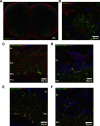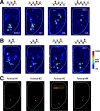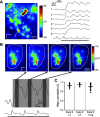Optical imaging of postsynaptic odor representation in the glomerular layer of the mouse olfactory bulb
- PMID: 19474178
- PMCID: PMC2724327
- DOI: 10.1152/jn.00020.2009
Optical imaging of postsynaptic odor representation in the glomerular layer of the mouse olfactory bulb
Abstract
Olfactory glomeruli are the loci where the first odor-representation map emerges. The glomerular layer comprises exquisite local synaptic circuits for the processing of olfactory coding patterns immediately after their emergence. To understand how an odor map is transferred from afferent terminals to postsynaptic dendrites, it is essential to directly monitor the odor-evoked glomerular postsynaptic activity patterns. Here we report the use of a transgenic mouse expressing a Ca(2+)-sensitive green fluorescence protein (GCaMP2) under a Kv3.1 potassium-channel promoter. Immunostaining revealed that GCaMP2 was specifically expressed in mitral and tufted cells and a subpopulation of juxtaglomerular cells but not in olfactory nerve terminals. Both in vitro and in vivo imaging combined with glutamate receptor pharmacology confirmed that odor maps reported by GCaMP2 were of a postsynaptic origin. These mice thus provided an unprecedented opportunity to analyze the spatial activity pattern reflecting purely postsynaptic olfactory codes. The odor-evoked GCaMP2 signal had both focal and diffuse spatial components. The focalized hot spots corresponded to individually activated glomeruli. In GCaMP2-reported postsynaptic odor maps, different odorants activated distinct but overlapping sets of glomeruli. Increasing odor concentration increased both individual glomerular response amplitude and the total number of activated glomeruli. Furthermore, the GCaMP2 response displayed a fast time course that enabled us to analyze the temporal dynamics of odor maps over consecutive sniff cycles. In summary, with cell-specific targeting of a genetically encoded Ca(2+) indicator, we have successfully isolated and characterized an intermediate level of odor representation between olfactory nerve input and principal mitral/tufted cell output.
Figures








Similar articles
-
GABAA and glutamate receptor involvement in dendrodendritic synaptic interactions from salamander olfactory bulb.J Physiol. 1993 Sep;469:315-39. doi: 10.1113/jphysiol.1993.sp019816. J Physiol. 1993. PMID: 7903696 Free PMC article.
-
Blocking of Dendrodendritic Inhibition Unleashes Widely Spread Lateral Propagation of Odor-evoked Activity in the Mouse Olfactory Bulb.Neuroscience. 2018 Nov 1;391:50-59. doi: 10.1016/j.neuroscience.2018.09.003. Epub 2018 Sep 9. Neuroscience. 2018. PMID: 30208337
-
Detecting activity in olfactory bulb glomeruli with astrocyte recording.J Neurosci. 2005 Mar 16;25(11):2917-24. doi: 10.1523/JNEUROSCI.5042-04.2005. J Neurosci. 2005. PMID: 15772351 Free PMC article.
-
The olfactory bulb: coding and processing of odor molecule information.Science. 1999 Oct 22;286(5440):711-5. doi: 10.1126/science.286.5440.711. Science. 1999. PMID: 10531048 Review.
-
Odor representation and coding by the mitral/tufted cells in the olfactory bulb.J Zhejiang Univ Sci B. 2024 Oct 15;25(10):824-840. doi: 10.1631/jzus.B2400051. J Zhejiang Univ Sci B. 2024. PMID: 39420520 Free PMC article. Review.
Cited by
-
Heterogeneous monotonic and non-monotonic responses to odor in mitral/tufted glomeruli of the mouse olfactory bulb.bioRxiv [Preprint]. 2025 Mar 6:2025.02.28.640652. doi: 10.1101/2025.02.28.640652. bioRxiv. 2025. PMID: 40093143 Free PMC article. Preprint.
-
In vivo functional properties of juxtaglomerular neurons in the mouse olfactory bulb.Front Neural Circuits. 2013 Feb 21;7:23. doi: 10.3389/fncir.2013.00023. eCollection 2013. Front Neural Circuits. 2013. PMID: 23459031 Free PMC article.
-
Plume Dynamics Structure the Spatiotemporal Activity of Mitral/Tufted Cell Networks in the Mouse Olfactory Bulb.Front Cell Neurosci. 2021 Apr 30;15:633757. doi: 10.3389/fncel.2021.633757. eCollection 2021. Front Cell Neurosci. 2021. PMID: 34012385 Free PMC article.
-
Mouse transgenic approaches in optogenetics.Prog Brain Res. 2012;196:193-213. doi: 10.1016/B978-0-444-59426-6.00010-0. Prog Brain Res. 2012. PMID: 22341327 Free PMC article. Review.
-
Design and application of genetically encoded biosensors.Trends Biotechnol. 2011 Mar;29(3):144-52. doi: 10.1016/j.tibtech.2010.12.004. Epub 2011 Jan 19. Trends Biotechnol. 2011. PMID: 21251723 Free PMC article. Review.
References
-
- Abraham NM, Spors H, Carleton A, Margrie TW, Kuner T, Schaefer AT. Maintaining accuracy at the expense of speed: stimulus similarity defines odor discrimination time in mice. Neuron 44: 865–876, 2004. - PubMed
-
- Aroniadou-Anderjaska V, Zhou FM, Priest CA, Ennis M, Shipley MT. Tonic and synaptically evoked presynaptic inhibition of sensory input to the rat olfactory bulb via GABA(B) heteroreceptors. J Neurophysiol 84: 1194–1203, 2000. - PubMed
-
- Aungst JL, Heyward PM, Puche AC, Karnup SV, Hayar A, Szabo G, Shipley MT. Centre-surround inhibition among olfactory bulb glomeruli. Nature 426: 623–629, 2003. - PubMed
-
- Berkowicz DA, Trombley PQ, Shepherd GM. Evidence for glutamate as the olfactory receptor cell neurotransmitter. J Neurophysiol 71: 2557–2561, 1994. - PubMed
Publication types
MeSH terms
Substances
Grants and funding
LinkOut - more resources
Full Text Sources
Miscellaneous

